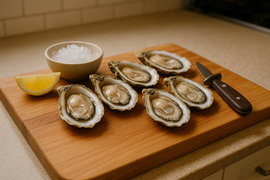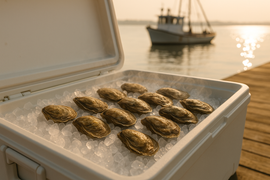Virginia oysters are famous for their unique flavors, shaped by the waters they grow in - called "merroir." The state produces over 40 million oysters annually, offering a wide range of taste profiles from salty to sweet. Here's what you need to know:
- 8 Oyster Regions: From the bold, salty Seaside oysters to the light, sweet Upper Bay Western Shore varieties, each region's salinity level defines the flavor.
-
Key Oyster Types:
- Blackberry® Reserve: Buttery, lightly salty, perfect raw.
- Smith Point: Creamy, salty-sweet, great for cooking.
- Peachtree: Balanced bay flavor, versatile for all preparations.
- How to Choose: Look for tightly closed, heavy shells with a fresh, briny smell.
- Storage Tips: Keep oysters at 35–45°F, cup-side down, and consume within 10–14 days.
Quick Comparison of Virginia Oyster Regions
| Region | Salinity (ppt) | Flavor Profile | Notable Traits |
|---|---|---|---|
| Seaside | 28–32 | Bold, salty | Sweet butter finish |
| Upper Bay Eastern Shore | 16–18 | Balanced, classic | Classic bay taste |
| Lower Bay Eastern Shore | 18–22 | Salty, creamy | Mellow sweetness |
| Upper Bay Western Shore | 10–17 | Sweet | Light cream taste |
| Middle Bay Western Shore | 16–18 | Lightly salty | Pleasant minerality |
| Lower Bay Western Shore | 16–18 | Mild salt | Sweet finish |
| Tidewater | 16–30 | Salty | Smooth, sweet finish |
| Tangier/Middle Bay | 16–18 | Balanced | Savory butter finish |
Virginia's oyster varieties are a true taste of the Chesapeake Bay, perfect for raw bars, grilling, or baking. Whether you prefer salty or sweet, there's a Virginia oyster for every palate.
Virginia's Main Oyster Growing Areas
Virginia's geography creates ideal conditions for oyster farming across eight regions, each shaped by unique water characteristics that influence flavor.
Map of Virginia's 8 Oyster Regions
These regions stretch from the Atlantic coast to the Chesapeake Bay's western shores:
- Seaside: Located along the Atlantic coast, known for oysters with the highest salinity (28–32).
- Upper Bay Eastern Shore: Found on the northern Eastern Shore bay coast, offering moderate salinity (16–18).
- Lower Bay Eastern Shore: Spanning Craddockville to Cape Charles, with salinity levels between 18–22.
- Upper Bay Western Shore: Covers the Potomac River to areas north of the Rappahannock River, featuring lower salinity (10–17).
- Middle Bay Western Shore: Encompasses the area around the Rappahannock River mouth, with moderate salinity (16–18).
- Lower Bay Western Shore: Includes the Mobjack Bay region and York River mouth, also with moderate salinity (16–18).
- Tidewater: Extends from south of Yorktown to Virginia Beach, with variable salinity levels (16–30).
- Tangier/Middle Chesapeake Bay: Covers Tangier Island and the north-central Chesapeake Bay, offering moderate salinity (16–18).
The salinity in each region plays a key role in defining the oysters' flavor profiles.
Water Conditions and Taste
"An oyster is a filter feeder, so if it feeds in salty waters, it's going to taste salty. If it goes upriver where there's less salt, then you get an oyster with a completely different flavor"
| Region | Salinity | Flavor Profile | Distinctive Traits |
|---|---|---|---|
| Seaside | Very High (28–32) | Bold, salty | Sweet butter finish |
| Upper Bay Eastern Shore | Moderate (16–18) | Balanced, classic bay | Classic Virginia bay taste |
| Lower Bay Eastern Shore | High (18–22) | Salty, creamy | Mellow sweetness |
| Upper Bay Western Shore | Low (10–17) | Sweet | Light cream taste |
| Middle Bay Western Shore | Moderate (16–18) | Lightly salty | Pleasant minerality |
| Lower Bay Western Shore | Moderate (16–18) | Mild salt | Sweet finish |
| Tidewater | Variable (16–30) | Salty | Smooth, sweet finish |
| Tangier/Middle Chesapeake Bay | Moderate (16–18) | Balanced | Savory butter finish |
The mix of freshwater and Atlantic saltwater creates a variety of oyster flavors. Virginia's title as the "Oyster Capital of the East Coast" is backed by its production of over 40 million oysters annually since 2016.
Next, we'll dive into the specific types of oysters and their standout characteristics.
Virginia Oyster Types
Virginia is home to a range of oysters, each shaped by the unique water conditions of the region. These oysters bring distinct flavors and textures, making them perfect for various culinary uses.
Key Oyster Types and Features
Little Wicomico Oyster Co. offers several varieties of cultivated oysters, each with its own flavor profile:
- Blackberry® Reserve Oysters: Available seasonally from October through March, these large oysters are priced at $189.00 for an 80-count order. They're a standout choice for raw bar presentations.
- Blackberry® Oysters: Grown year-round in the Middle Bay Western Shore, these oysters thrive in moderate salinity (16–18). They deliver a lightly salty taste with buttery notes and a hint of minerality.
- Smith Point Oysters and Rock Hole Oysters: Harvested from the Lower Bay Eastern Shore, where salinity ranges from 18–22, these varieties offer a salty, creamy flavor with a touch of sweetness. They're great for both raw consumption and cooking.
- Peachtree Oysters: Known for their balanced salt and sweet profile, these oysters capture the essence of traditional bay flavors.
Oyster Type Comparison Chart
| Oyster Variety | Region | Salinity Level | Flavor Profile | Best Serving Method |
|---|---|---|---|---|
| Blackberry® Reserve | Middle Bay Western Shore | 16–18 | Buttery with light salt | Raw on half shell |
| Blackberry® | Middle Bay Western Shore | 16–18 | Balanced minerality, creamy finish | Raw or grilled |
| Smith Point | Lower Bay Eastern Shore | 18–22 | Salty-sweet, creamy | Rockefeller style |
| Rock Hole | Lower Bay Eastern Shore | 18–22 | Bold brine with a quick finish | Raw or broiled |
| Peachtree | Upper Bay Eastern Shore | 16–18 | Classic bay taste, balanced | All preparations |
"From salty to sweet, buttery to briny, Virginia's oysters taste just like the waters they came from-- whether it's the mighty Rappahannock, the Chesapeake Bay, or the Atlantic Ocean." - Patricia Keppel Anderson
Each oyster variety tells the story of the waters it comes from, offering a taste experience tied to its origin. Up next, find out how to choose oysters that suit your preferences.
sbb-itb-5051793
How to Choose Virginia Oysters
Signs of Fresh Oysters
When selecting oysters, look for ones with tightly closed, heavy shells. A quick tap should make the shell close tightly. The shells should also be free of cracks and have a fresh, briny smell, reminiscent of the ocean.
Avoid oysters that show these signs:
- Cracked or damaged shells
- A lightweight or hollow feel
- Stay open even after being tapped
- Have an unpleasant or off smell
Once you've ensured the oysters are fresh, you can explore their flavors by considering the characteristics of different regions.
Finding Your Preferred Taste
Virginia boasts eight oyster regions, each with its own flavor profile influenced by local water conditions, also known as "merroir." To guide your choice, consider the salinity level:
For example, oysters from The Middle Bay Western Shore, like Little Wicomico Oyster Co.'s Blackberry® oysters, have a moderate salinity level (16-18). This gives them a balanced flavor with light saltiness and buttery undertones.
Farming techniques also play a role in shaping an oyster's flavor and texture.
Oyster Farming Methods
Virginia's farming practices contribute greatly to the quality of its oysters:
- Bottom-Cultured: These oysters grow directly on the bay floor, resulting in thicker shells and a distinct mineral taste. Little Wicomico's Smith Point and Rock Hole oysters are excellent examples of this method.
- Float-Raised: Grown suspended in the water column, these oysters tend to have cleaner shells and more uniform shapes. Little Wicomico's Blackberry® Reserve oysters follow this method, offering a premium look and flavor.
Both methods highlight the care and precision that go into producing Virginia's diverse and high-quality oysters.
Serving and Pairing Virginia Oysters
Drink Pairings
Pairing oysters with the right drink enhances their natural flavors. A crisp beverage, especially wine, complements the oysters' saltiness and oceanic taste.
"A bright, crisp white wine is the quintessential beverage pairing for freshly shucked oysters. The right wine cuts through the oysters' saltiness while complementing their delicate ocean essence." – Little Wicomico
Here are some top wine choices to consider:
- Sauvignon Blanc: Look for varieties with hints of grapefruit and lemongrass.
- Unoaked Chardonnay: Offers a richer, fuller-bodied flavor.
- Sparkling Wines: Champagne, Prosecco, or Cava add a refreshing touch.
If you prefer beer, a dry Pilsner-style option works beautifully with oysters, thanks to its clean and crisp profile. Now, let’s dive into how preparation methods can elevate the oyster experience.
Preparation Methods
How you prepare oysters plays a big role in how their flavors shine.
Raw Presentation:
- Serve with mignonette sauce (a mix of minced shallots, red wine vinegar, and cracked black pepper) for a tangy kick.
- Arrange on a bed of crushed ice to keep them fresh and visually appealing.
Cooked Options:
- Grill them alongside asparagus for a smoky twist.
- Bake with a crispy bacon topping for a savory finish.
Little Wicomico's Blackberry® Reserve Oysters are especially prized for their raw presentation, as it highlights their natural flavor.
Storage Guidelines
Proper storage is essential to keep oysters fresh and safe to eat. Follow these tips:
- Temperature: Keep oysters between 35–45°F.
For Shucked Oysters:
- Store in the coldest part of your refrigerator.
- Consume within 10–14 days of receiving them.
For Shell-On Oysters:
- Place them cup-side down in the fridge.
- Cover with a damp paper towel to prevent drying out.
- Avoid storing them in standing water.
- In colder months, they can stay fresh for up to a month.
Freshness Indicators:
- Fresh oysters should smell like the ocean - clean and briny.
- Discard any with a strong "fishy" odor.
- Shells should be tightly closed. If a shell is open and doesn’t close when tapped, it’s time to toss it.
Summary
Virginia earns its title as the Oyster Capital of the East Coast with annual sales exceeding 40 million oysters and eight regions producing oysters with distinct flavor profiles, or 'merroir'
From the bold, salty flavors of Seaside oysters to the buttery finish of Tangier Bay varieties, Virginia oysters offer a wide range of taste experiences. Seaside oysters are known for their intense saltiness, while Tangier/Middle Chesapeake Bay oysters stand out for their creamy and sweet notes.
"These are some of the finest oysters I have ever tried!" - Arthur Richards
Little Wicomico's oysters capture the essence of Virginia's diverse growing regions. They balance the sharp salinity of seaside oysters with the more nuanced flavors of bay varieties.
Here are a few tips for enjoying oysters at their best:
- Keep oysters stored between 35–45°F and select varieties that match your flavor preferences.
- Always choose fresh oysters with tightly closed shells.
- Follow proper storage practices to preserve their quality.
Little Wicomico delivers oysters that highlight the best of Virginia's regions, ensuring freshness and flavor right to your table.
FAQs
What makes Virginia oysters taste unique, and how does their environment influence their flavor?
Virginia oysters owe their unique flavors to the waters where they are harvested. Factors like salinity, mineral content, and nutrients in the water - collectively known as merroir - shape their taste, much like how a vineyard's soil influences wine. Depending on the region, Virginia oysters can range from sweet and buttery to briny and bold.
Virginia is home to eight distinct oyster regions, each offering a signature flavor profile. For example, oysters from saltier waters may have a sharper, brinier taste, while those from nutrient-rich, less salty areas might be milder and creamier. This diversity makes Virginia oysters a versatile choice for pairing with your favorite beverages or recipes.
How can I tell if the oysters I’m buying are fresh and safe to eat?
To ensure your oysters are fresh and safe, check that the shells are tightly closed or snap shut when tapped. Avoid oysters with cracked or broken shells. Fresh oysters should have a clean, ocean-like aroma - steer clear of any with a strong fishy or unpleasant smell.
If you're buying shucked oysters, the meat should be plump, creamy tan in color, and smell fresh. Always check that oysters have been properly stored on ice and aim to consume them within four days of harvest for the best quality. Following these tips will help you enjoy oysters at their freshest and safest!
What are the best drinks to pair with Virginia oysters to bring out their natural flavors?
The right drink can elevate the natural flavors of Virginia oysters, enhancing their briny, sweet, or buttery profiles. For a classic pairing, crisp white wines like Sauvignon Blanc or an unoaked Chardonnay work beautifully, balancing the oysters' salinity with their refreshing acidity. Prefer bubbles? A dry Champagne or sparkling wine adds a touch of elegance, with effervescence that complements the delicate ocean notes of the oysters. For beer lovers, a pilsner-style draft beer is a great choice, offering a light, clean finish that doesn't overpower the oysters' taste. Whether you choose wine, beer, or even a classic martini, the key is to let the oysters shine!





